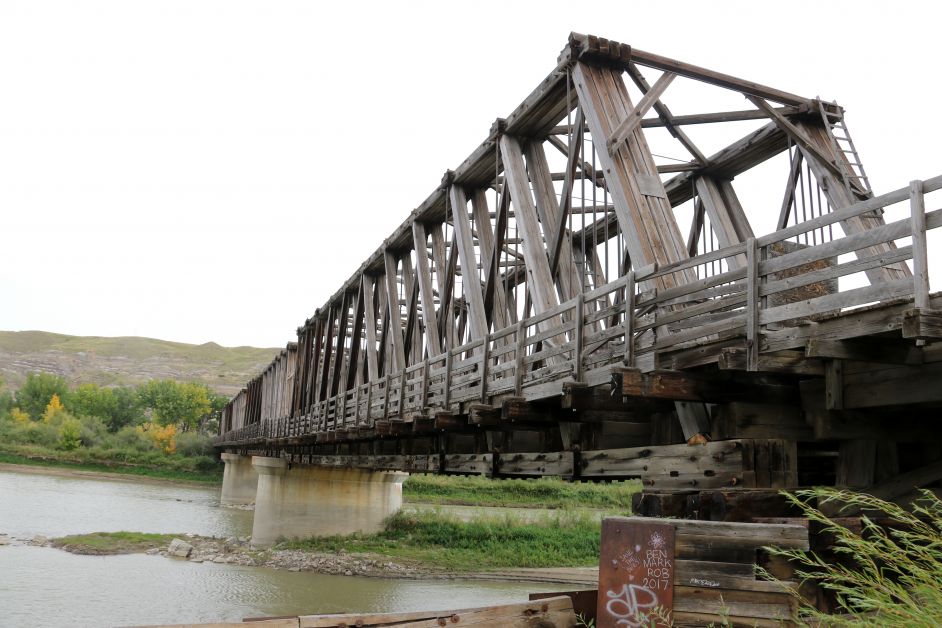The East Coulee Truss Bridge, once named one of Canada’s most endangered places, remains fenced off to the public as the Atlas Coal Mine continues “quietly working” toward an agreement with CP Rail to restore the derelict bridge.
Atlas Coal Mine executive director Sarah Newstead says her and past directors have been working for the last 25 years to find a way to restore the wooden bridge, which she says is a nationally significant resource that has been slowly deteriorating before their eyes.
The wooden bridge, which was first built in 1936 but rebuilt shortly after a 1948 flood damaged it, is owned by Canadian Pacific Rail, which has participated in a number of discussions with the Atlas Coal Mine and other community partners, but Newstead says CP has always seemed “non-committal” in either turning over the bridge to the mine or selling off the property, even if it includes a significant piece of local history. She says it’s an issue for historic rail properties across Canada.
“It would give precedent for thousands of other communities in Canada that have derelict rail properties. We’re talking potentially billions of dollars in property, CP and CN are some of the biggest landowners in Canada,” she says.
The Atlas and other East Coulee residents have for a number of years voiced their concern over the bridge, which used to be open access until CP put up fences and closed off the property a number of years ago. Attempts have been made by the community to either purchase the site or come to an agreement with CP Rail, but Newstead says CP has so far been reluctant to part with the property.
“Canadian Pacific continues to evaluate the next steps to take with the bridge,” Salem Woodrow, media relations for CP, said in an email, but did not indicate what those next steps might be.
Newstead says those who want to see the bridge rehabilitated are facing a ‘catch-22,’ where they are unable to raise the funds needed for an extensive restoration (estimated at over $1 million) since CP Rail has not indicated the property will ever be made available. She says the Atlas board would not be willing to raise funds for a bridge that isn’t guaranteed to be available for purchase, but at the same time that means there is no funds to draw from in the event CP decides to sell the bridge.
“It’s breaking my heart to just see it out there,” Newstead says.
While the bridge is technically part of their national historic designation, it is the provincial designation which would provide the Atlas “with some teeth” to protect the bridge, which would require CP Rail, as the property owner, to sign off on. If that were to ever happen, Newstead says they “have all our ducks in a row” to make the restoration happen.
“We need to recognize it as a nationally important structure that needs conservation at the highest level so it’s conserved forever and not just in the short term,” she says.
The wooden bridge is a rare, living example of a “Howe Truss” bridge, first patented in the mid-1800s and primarily used in the 19th century for bridges across North America. After the original bridge was destroyed, it was rebuilt with the same design shortly after and used to ship coal from East Coulee’s mines until the Atlas Mine closed in the mid-1970s. The Atlas Mine, and the bridge included on the site, have since been recognized as an Alberta Provincial Heritage Resource and a National Historic Site of Canada.
In 2015, the bridge was listed as one of the most endangered places in Canada by the National Trust for Canada, a non-profit which aims to protect historic places in the country.
“The costs of maintenance and conservation, and the issue of assuming insurance liability has dissuaded the Atlas Coal Mine Historical Society and the community of East Coulee from assuming ownership,” the trust says on their website. “A concerted cost-shared conservation effort is required now to ensure the ongoing sustainability of this nationally significant example of bridge architecture.”
While the residents of East Coulee and the Atlas Coal Mine hope these efforts are successful, for now, the fate of the East Coulee Truss Bridge is stalled. But there may be hope. The Town of Drumheller has been in talks with CP to reach an agreement to use the former rail line property, which runs through town all the way out to East Coulee, as some kind of walking trail. Newstead hopes if the town is successful there, the Atlas may be able to piggy-back on that agreement to get the bridge. But Mayor Heather Colberg told the Mail there hasn’t been anything firm in their talks with CP yet.
“There is nothing concrete to say at this moment,” she said.
Local John Barry Graham has organized the Badlands Boogie in order to raise funds to save the bridge. But the annual music festival at his property has only raised about $4,000 in the last five years for the effort, far short of the $1 million endowment Newstead says would be needed to get a restoration project rolling.
But time is ticking. When the bridge was surveyed more than five years, engineers said the bridge was in “good shape,” but it has been shifting over the years. River ice flows each spring can cause damage to the bridge, so each year brings another threat to the already decaying bridge.






















